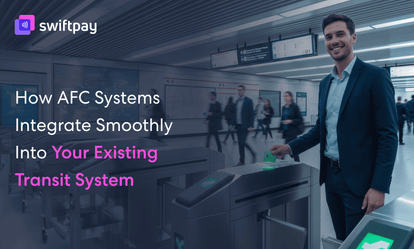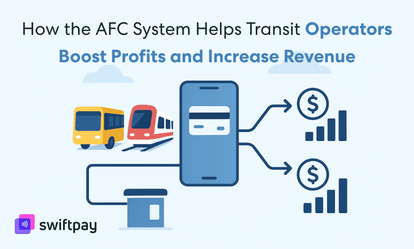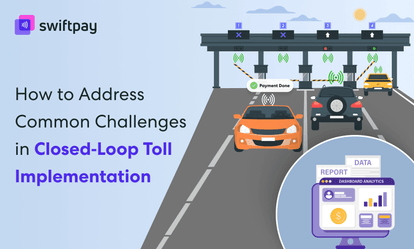Why do so many people still choose cars or other private vehicles over public transport, even when it’s slower, pricier, and worse for the planet?
The answer often comes down to one word: convenience, and convenience drives choice. People won’t switch to public transport unless it offers a superior experience.
Humans crave ease, and traditional fare collection systems—cash-only booths, paper tickets, confusing reload processes—no longer align with the expectations of the urban population.
That’s why smart auto fare collection systems are required in public transport. These systems don’t just simplify payments. They make every step of the journey or commute smoother, faster, and more appealing.
But what makes these systems truly effective? And how can operators use them to build loyalty among first-time users? We’ll break it all down here.
Let’s get into it.
What makes public transport payments inefficient
When fare collection systems don’t keep pace with user expectations, the problems compound quietly.
What starts as a small friction—a card that doesn’t scan, a fare rule that’s too complex, or a lack of multiple payment options—becomes a reason not to ride at all. Let’s explore the consequences operators like you face with traditional transport payment systems:
Long wait times at boarding points
Nothing kills efficiency faster than a line at the entry gate. It’s not good for you and your customers as well.
Whether it’s caused by slow card readers, cash payments, or confused passengers, every second of delay adds up.
It extends journey times, frustrates staff and commuters, and reduces the overall efficiency of public transport, especially during peak hours when speed matters most.
Confusing fare structures
Flat fares? Zonal pricing? Off-peak discounts that only apply to certain modes? Public transport often has complex fare structures.
But the thing is that passengers, especially occasional users and tourists, shouldn’t need a fare chart and a calculator to figure out what they have to pay. Complex pricing introduces hesitation, and hesitation turns into lost ridership.
Payment failures at the point of entry
One failed payment is all it takes to turn a routine commute or journey into a stressful experience.
It doesn’t matter if that happens through a network issue, expired card, or insufficient balance; these moments create embarrassment, delays, and distrust in public transit payment systems.
Inconvenience for unbanked or underbanked riders
If your transit system relies entirely on open-loop payments—credit cards, debit cards, or app-based wallets—you leave out a significant portion of the population from using public transportation.
The reality is that many people still don’t have consistent access to banking tools. Hence, fare collection systems must accommodate them with prepaid options or closed loop wallets that don’t require a bank account.
Poor user experience and lower rider retention
Every passenger who feels frustrated, confused, or excluded is a potential customer lost to ride-hailing or private vehicles.
If they keep having negative experiences repeatedly, then their trust in public transportation will erode. And if they share such experiences with others, then ridership numbers may even decline further.
What people expect from transit payment systems
Public transport isn’t competing against other buses or metro lines. It’s competing against the simplicity of ordering a rideshare or tapping a phone to rent a scooter.
Most people now expect the same ease, speed, and transparency from every service they use. Let’s see what they can be in terms of public transportation:
Fast, seamless entry without queues
Speed is non-negotiable. Modern users want to tap, scan, and move—no waiting, no cash payments, no puzzling over machines.
The less friction at the gate, the more likely passengers are to choose public transit over alternatives.
Unified access across all modes of transit
Whether your customers are hopping on a metro, transferring to a bus, or catching a ferry, they expect one payment system to work everywhere.
So when they have to use separate cards or different apps, it creates unnecessary barriers.
Transparent pricing and instant confirmation
Users want clarity. What am I being charged? Is there a fare cap? Will I get a discount if I ride more?
Hence, your transit payment system should communicate this instantly—via app notification, text message, or email. This helps build confidence and reduces anxiety among your users.
Options that match their payment habits
Not everyone pays the same way. People are used to paying in specific ways. Some prefer mobile wallets and contactless payments. Others rely on QR codes, physical cards, or even wearables.
That means your fare collection system should support all major options. Because one size never fits all.
How automated fare collection can encourage more public transport use
When public transport feels like a chore before the journey even begins, it’s no surprise that many people avoid it.
Fare collection is often the first touchpoint in the journey—and if it creates stress, confusion, or delays, many simply opt for alternatives.
Let’s break down how a smarter payment system like auto fare collection removes those mental and logistical hurdles and encourages more people to choose public transit willingly and repeatedly:
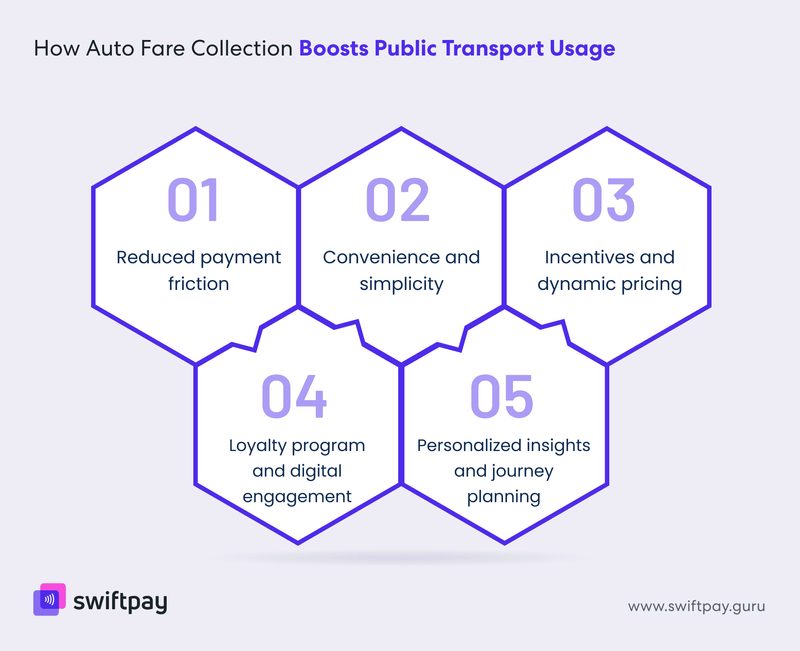
Removes friction that deters first-time users
Trying public transit for the first time can be overwhelming for many. Is it cash only? Do you need a special card? Where do you buy it? What if you pick the wrong ticket? People’s minds get flooded with those kinds of questions.
Automated fare collection simplifies this entire experience. With mobile apps, tap-to-enter (contactless payment) options, and clear pricing, first-time users aren’t forced to decode complex fare pricing. They can just move confidently and quickly.
This convenience lowers the mental threshold for using public transit and creates a smoother onboarding experience for new users.
Builds passenger confidence through simplicity
A transit system that works effortlessly gives people peace of mind. This means passengers don’t have to worry about rejected cards, needing exact change, or figuring out fare zones under pressure.
When transit payments become invisible in the process—quick, seamless, and dependable—riders feel in control. That emotional reassurance goes a long way in building long-term loyalty.
Incentivizes off-peak travel with dynamic pricing
A rigid pricing model ignores opportunity. With a smart AFC system, you can dynamically lower fares during off-peak hours to spread demand and ease overcrowding.
It’s not just about operational balance; it’s about giving people reasons to travel more often.
For instance, a student might hop on a bus after class if fares are lower at that hour. Or a part-time worker might shift their commute to save money. Flexible transit payment and fare models show that you consider everyone’s needs.
Enables loyalty programs and digital engagement
Passengers usually expect some kind of reward, especially if they are regular.
With automatic fare collection systems, you can reward riders who take 10 trips in a week with a free ride, or you can offer bonuses for eco-friendly choices like switching from personal vehicles to public transport
These systems enable this kind of engagement, which taps into emotional motivation. People love being rewarded. They enjoy tracking progress. And most importantly, they appreciate being recognized.
Hence, this kind of personalization and feedback loop turns commuting into a relationship, not just a transaction.
Allows for personalized travel insights and planning
Advanced AFC platforms can do more than just charge fares. They can help riders make smarter choices—suggesting alternate routes, flagging delays, or recommending faster connections.
These real-time, personalized insights turn transit from something you “put up with” into something that actually works for you. That’s how you shift public sentiment and boost rider satisfaction.
What is closed-loop AFC?
A closed-loop automatic fare collection (AFC) system is like a private payment ecosystem designed exclusively for public transportation payments.
It allows your passengers to pay for their transport using a dedicated closed-loop prepaid card, app, or e-wallet that’s tied directly to your transit network.
Unlike general-purpose (or open-loop) payment methods—like bank cards or mobile wallets that work anywhere—funds loaded into this system are locked in for transit use within your network only. It is like your own branded currency for your network
Passengers preload value into their smart transit cards or e-wallet apps managed directly by the transport authority like yours. Users can set up subscriptions, activate auto top-ups, or use prepaid options—without needing a bank account.
Why transit operators should prioritize closed-loop auto fare collection
Many payment systems promise flexibility or modernization, but a few offer the strategic depth of a well-designed closed-loop system.
This is where transit operators like you have the chance to move from reactive fixes to proactive planning. Here’s how closed-loop auto fare collection is beneficial:
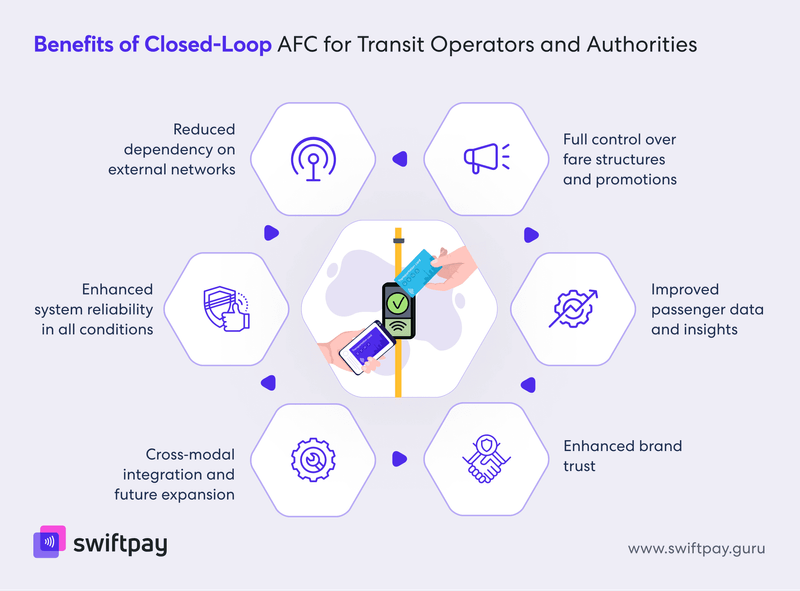
Reduced dependency on external networks
Relying on open-loop systems means relying on banks, card schemes, and external payment processors—all of which come with risks. Network outages, rising interchange fees, and limited flexibility can disrupt service and inflate costs.
A closed-loop payment system cuts those ties. Operators like you remain in full control of the payment rails, which reduces exposure to third-party issues and helps you build a more resilient infrastructure.
Full control over fare structures and promotions
Want to offer 50% off rides for students during exam season? Or give loyalty perks to seniors who ride 30 times a month? With closed-loop AFC, you can.
You’re not dependent on third-party tools or fixed pricing constraints. You can create and deploy promotions, modify rules, and respond to ridership trends in real time.
This agility isn’t just convenient. It’s crucial for modern transit planning.
Enhanced system reliability in all conditions
Many open-loop systems rely on real-time network connections to validate payments. But what happens when there’s no signal—in tunnels, remote areas, or during emergencies?
Closed-loop automated fare collection platforms can operate in offline mode as well. Whether it’s a rainy day in a rural town or peak hour in a packed metro station, the system keeps working, delivering uninterrupted access.
Improved passenger data and insights
Data is one of your most valuable assets. A closed-loop system gives you direct access to rich, granular insights into rider behavior without involving intermediaries.
You can track usage patterns, identify underserved routes, and measure the impact of specific policies with confidence. And because the data never leaves your ecosystem, it stays secure, private, and compliant.
Cross-modal integration and future expansion
Public transit is no longer limited to buses and metros. Micro-mobility options like bike-share, scooter rentals, or even electric car charging have become a part of the same ecosystem.
A flexible closed-loop payment platform allows you to bring these services under one account. This allows your users to tap into all mobility options without switching apps or wallets, creating a unified, smart city-ready experience.
Enhanced brand trust with a cohesive digital experience
When riders interact with a single, intuitive interface—from payments to trip history to customer support—it builds brand trust.
They feel connected to the service provider, not lost in a web of third-party systems. That trust fosters loyalty, encourages feedback, and helps you build long-term ridership from the ground up.
Read more - Revolutionize Fare Collection with Closed-Loop AFC Systems
Key takeaways for stakeholders
Public transport systems today face rising expectations and tighter margins. To win over more passengers and keep operations efficient, the fare experience must become a core strategic focus.
Smart payment systems like auto fare collection systems remove the barriers that prevent people from choosing public transit. They simplify access, improve transparency, and give operators the tools they need to manage growth and policy with precision.
Closed-loop AFC, in particular, stands out as the ideal solution.
If you are looking to take full control of the payment lifecycle, you don’t have to think twice. It’s cost-efficient, customizable, and ready for the future of urban mobility.
For policymakers, authorities, and private transport providers like you, the message is clear: treat seamless and smart transit payment systems more like a necessity rather than a luxury.
At SwiftPay, we help transit operators like you implement scalable and customized closed-loop AFC solutions that elevate both rider experience and operational efficiency.
If you're ready to future-proof your transit network, we’re ready to partner with you.
Because the way forward isn’t just about moving people. It’s about making every journey and commute easier, fairer, and more reliable.


